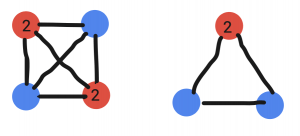How Clusters and Thresholds Led to an Unexpected Trump Win in 2016
According to polling data during the 2016 election, a Trump victory was impossible. Hillary Clinton was projected to win and no one had any doubts. A grand fireworks show was planned to occur over the Hudson River on election night, but it was quietly called off a few days earlier (Musumeci). At 2:30 AM, the impossible happened: Donald Trump won the last electoral votes that he needed in order to put him over the 270 threshold (McCarthy). He was going to be the next President of the United States.
Lots of Americans believed that it would be Hillary Clinton that claimed this position—the first woman in history to do so. So what really happened? Where did all of these Trump voters come from, and why didn’t the polls account for them? According to a study led by Columbia Business School professor Micheal Slepian, “a 54% majority of voters who concealed their true preference for a candidate supported Donald Trump in 2016” (Bernstein). “In a study of 1,000 people conducted in the days after the election, the researchers found that 57% of men and 50% of women secretly voted for Trump” (Bernstein).
Voters told researchers that they “were most concerned about how their reputations would be impacted if others found out they supported a particular candidate” (Bernstein). They worried about jeopardizing friendships and relationships or being isolated from community organizations (Bernstein). Finally, they “justified their secrecy in the hopes of keeping the peace and avoiding conflict” with loved ones that they disagreed with (Bernstein).
After taking INFO 2040 and learning about network effects, clusters, and thresholds, this behavior isn’t surprising. These so-called ‘closet Trump supporters’ feared being honest about the candidate that they were casting a ballot for because they didn’t feel like enough people in their close circles felt the same way. However, there were actually a lot more Trump supporters around them than they thought.
We can think about how the structure underlying social networks can have an impact on the way that people make decisions and disclose their opinions to the public. Suppose that the image below of different clusters represents friend groups, with all edges indicating strong ties. The red nodes are Trump voters and the blue nodes are Clinton voters. The numbers inside the red nodes represent thresholds, which are how many other people the individual needs to see publicly support Trump in order for them to also be comfortable publicly supporting Trump. A threshold represents someone’s willingness to make their opinions public. For example, the red node in the top left corner will need to see 2 other people publicly support Trump in order for them to also be public about who they are voting for. The node in the bottom right corner feels the same way. Therefore, neither of them will publicly support Trump. Similarly for the friend group on the right, the red node will not publicly support Trump because his threshold of 2 was not met. If all of these people knew that they were all Trump supporters, then all of their thresholds would be met. However, since they are a part of different clusters, none of them will share their viewpoints publicly. If we imagine this on a greater scale, we can see how there were a lot more Trump supporters than everyone originally thought, because a lot of people refrained from speaking out publicly in fear of what their peers would think.
In 2016, it seemed like not that many Trump supporters existed because few people were speaking out publicly. However, if we take into consideration all of the Trump supporters in each social circle that weren’t necessarily open about their viewpoints, we can see how the numbers can quickly add up. This phenomenon is known as pluralistic ignorance, “in which people have wildly erroneous estimates about the prevalence of certain opinions in the population at large” (Easley). This extreme underestimation led to the somewhat shocking results of the 2016 election where Donald Trump defeated Hillary Clinton.
Bernstein, Leandra. “Trump Won the Majority of ‘Secret’ Voters in 2016, Study Finds.” WJLA, wjla.com/news/nation-world/trump-won-the-majority-of-secret-voters-in-2016-study-finds.
McCarthy, Ciara, and Claire Phipps. “US Election 2016 Results Timeline: How the Night Unfolded.” The Guardian, Guardian News and Media, 9 Nov. 2016, www.theguardian.com/us-news/2016/nov/08/presidential-election-updates-trump-clinton-news.
Musumeci, Natalie. “Clinton Calls off Election Night Fireworks.” New York Post, New York Post, 7 Nov. 2016, nypost.com/2016/11/07/clinton-calls-off-election-night-fireworks/.
“19.6 Knowledge, Thresholds, and Collective Action.” Networks, Crowds and Markets: Reasoning about a Highly Connected World, by David Easley and Jon Kleinberg, Cambridge University Press, 2019, pp. 583.

